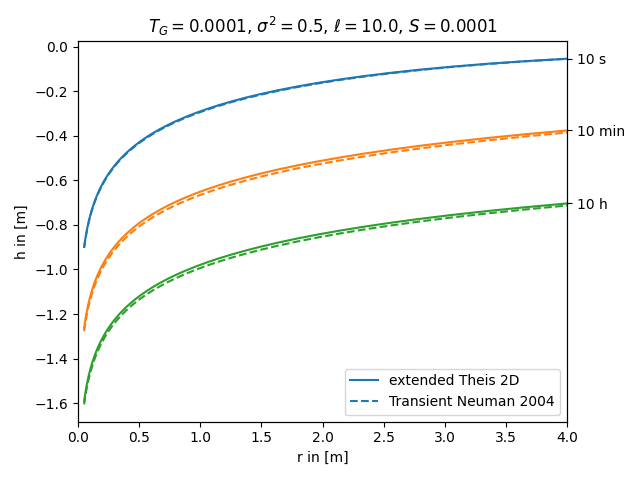Note
Click here to download the full example code
extended Theis 2D vs. transient solution for apparent transmissivity from Neuman¶
Both, the extended Theis and the Neuman solution, represent an effective transient drawdown in a heterogeneous aquifer. In both cases the heterogeneity is represented by two point statistics, characterized by mean, variance and length scale of the log transmissivity field. Therefore these approaches should lead to similar results.
References:

import numpy as np
from matplotlib import pyplot as plt
from anaflow import ext_theis_2d, neuman2004
time_labels = ["10 s", "10 min", "10 h"]
time = [10, 600, 36000] # 10s, 10min, 10h
rad = np.geomspace(0.05, 4) # radius from the pumping well in [0, 4]
TG = 1e-4 # the geometric mean of the transmissivity
var = 0.5 # correlation length of the log-transmissivity
len_scale = 10.0 # variance of the log-transmissivity
S = 1e-4 # storativity
rate = -1e-4 # pumping rate
head1 = ext_theis_2d(time, rad, S, TG, var, len_scale, rate)
head2 = neuman2004(time, rad, S, TG, var, len_scale, rate)
time_ticks = []
for i, step in enumerate(time):
label1 = "extended Theis 2D" if i == 0 else None
label2 = "Transient Neuman 2004" if i == 0 else None
plt.plot(rad, head1[i], label=label1, color="C" + str(i))
plt.plot(rad, head2[i], label=label2, color="C" + str(i), linestyle="--")
time_ticks.append(head1[i][-1])
plt.title(
"$T_G={}$, $\sigma^2={}$, $\ell={}$, $S={}$".format(TG, var, len_scale, S)
)
plt.xlabel("r in [m]")
plt.ylabel("h in [m]")
plt.legend()
ylim = plt.gca().get_ylim()
plt.gca().set_xlim([0, rad[-1]])
ax2 = plt.gca().twinx()
ax2.set_yticks(time_ticks)
ax2.set_yticklabels(time_labels)
ax2.set_ylim(ylim)
plt.tight_layout()
plt.show()
Total running time of the script: ( 0 minutes 0.272 seconds)